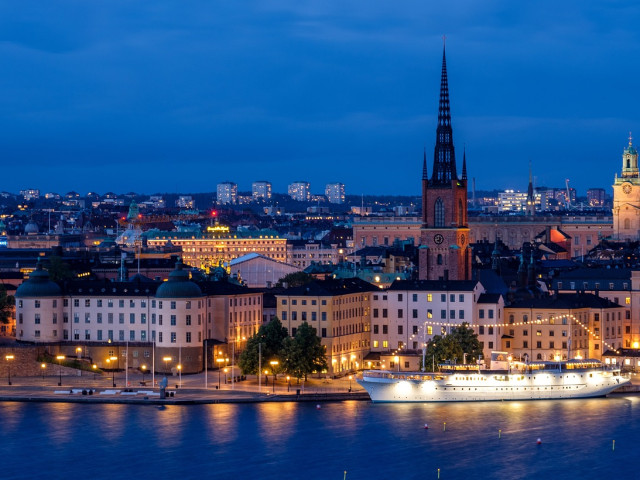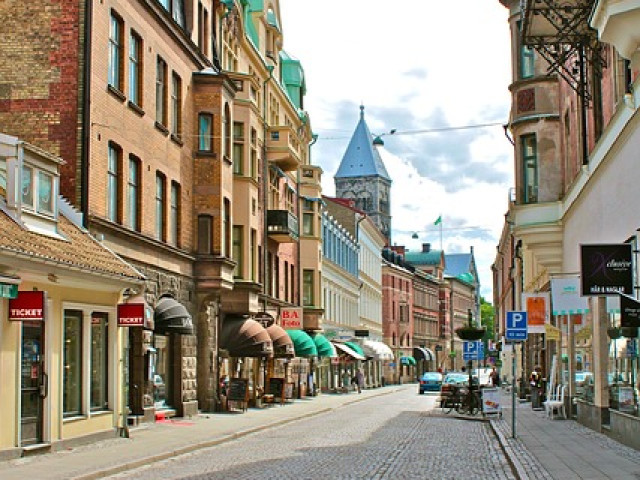
| Capital | Stockholm |
| Currency | Swedish Krona |
| Languages | Swedish |
| Government | Constitutional monarchy |
| Timezone | GMT + 1 |
| Population | 9 million |
| Dialing code | (00) 46 |
Sweden is not the cheapest country you could travel to, but it surely is worth spending a bit more money as the things you will get to see will definitely make up for it. Getting around in Sweden is easy since the public transport system is excellent. The standard of living is generally high which means that even hostels and other cheaper types of accommodation are of good quality. Things like hiking, camping in forests or sunning on one of the beautiful beaches are free, so there’s plenty to do even if you don’t want to spend a fortune.
Where to buy tickets for Sweden
The Trainline
Booking Platform
The Trainline is a British digital rail and coach technology platform operating across Europe.
Visit The TrainlineSponsored Link
Omio
Booking Platform
Omio is a German online travel comparison and booking website based in Berlin.
Visit OmioSponsored Link
SJ
National Operator
SJ (formally SJ AB) is a government-owned passenger train operator in Sweden.
Visit SJMore places to go in Sweden
What to expect from the weather in Sweden
Sweden’s climate is relatively mild although it varies greatly, depending where in Sweden you are. Summers can be very hot but the further north you get the shorter the summers. Average temperatures in summer are usually around 20°C - 25°C, although it sometimes gets even warmer. Between mid-May and mid-June you can see the midnight sun above the Arctic Circle.
Winters are often really cold, especially in the north of the country; the days there are shorter and heavy frosts and snowfalls can be expected, especially from January to March. In winter, temperatures normally range from -7°C to 2°C.
July and August tend to be the wettest months.
Winters are often really cold, especially in the north of the country; the days there are shorter and heavy frosts and snowfalls can be expected, especially from January to March. In winter, temperatures normally range from -7°C to 2°C.
July and August tend to be the wettest months.
Accommodation
Hotels are generally of a high standard with a good variety to be found in almost every Swedish town. You get private hotels as well as hotels operated by large hotel groups. All over Sweden there are independently run country hotels, which offer good, often traditional food and in many cases they’re located in stunning settings, such as in manor houses or old farmhouses.
There are working farms throughout Sweden which offer accommodation either in the main farmhouse or in a cottage near the main building. Accommodation is normally on a bed & breakfast basis, with self-catering facilities. Bookings can be made through local tourist offices.
Forest cabins and chalets are another option, generally set in beautiful surroundings, near lakes, quiet forests or on an island.
Family camping holidays are very popular in Sweden and there is a huge range of attractive sites. There are over 600 campsites, most are located on a lakeside or by the sea. Most sites are open from 1st June to 15th August. Many sites are also open in April or May; in winter, 200 sites remain open, particularly in the winter sports areas in central and northern Sweden. Rough camping is tolerated in many areas. A useful alternative to the usual tent or caravan camping is renting one of 4400 camping cabins which are available at many sites. They generally contain bunk beds and kitchen equipment.
There are more than 300 hostels in Sweden, most have two to four beds per room or family rooms. There are no restrictions on who may stay in which of Sweden’s hostels, which means you don’t have to be a member of any hostel related organization. The majority of hostels are open during the summer and many stay open for the whole year.
There are working farms throughout Sweden which offer accommodation either in the main farmhouse or in a cottage near the main building. Accommodation is normally on a bed & breakfast basis, with self-catering facilities. Bookings can be made through local tourist offices.
Forest cabins and chalets are another option, generally set in beautiful surroundings, near lakes, quiet forests or on an island.
Family camping holidays are very popular in Sweden and there is a huge range of attractive sites. There are over 600 campsites, most are located on a lakeside or by the sea. Most sites are open from 1st June to 15th August. Many sites are also open in April or May; in winter, 200 sites remain open, particularly in the winter sports areas in central and northern Sweden. Rough camping is tolerated in many areas. A useful alternative to the usual tent or caravan camping is renting one of 4400 camping cabins which are available at many sites. They generally contain bunk beds and kitchen equipment.
There are more than 300 hostels in Sweden, most have two to four beds per room or family rooms. There are no restrictions on who may stay in which of Sweden’s hostels, which means you don’t have to be a member of any hostel related organization. The majority of hostels are open during the summer and many stay open for the whole year.
What are the business hours?
Banks will open Monday - Friday 09.30-15.00 or until 17.30 in some larger cities. Shops are generally open Monday-Friday 09.00/09.30-17.00/18.00, although this will be until 20.00/22.00 for larger stores. On Saturdays shop opening hours are typically 09.00/09.30-13.00/16.00 and some of the bigger shops also open Sundays from 12.00-16.00.
What about travel visas?
EU nationals are only required to produce evidence of their EU nationality and identity in order to be admitted.
Sweden is a signatory to the 1995 Schengen Agreement. For further details about passport/visa regulations within the Schengen area, see relevant embassy website.
Sweden is a signatory to the 1995 Schengen Agreement. For further details about passport/visa regulations within the Schengen area, see relevant embassy website.
How much should you tip in Sweden?
Tipping is not mandatory, however, if you were happy with the service you received, it is common to round the amount of the bill up or simply to leave 5-10% of the price behind.
Taxi drivers will also appreciate it if you round the bill up and give a couple of kronor extra, but insofar as hairdressers, beauty therapists, etc. are concerned, tipping is not the norm.
Taxi drivers will also appreciate it if you round the bill up and give a couple of kronor extra, but insofar as hairdressers, beauty therapists, etc. are concerned, tipping is not the norm.
| ATM availability | Available |
| Emergency services | Ambulance, police and fire 112 |
| Tourist board | http://www.visitsweden.com |
| Famous for | Vikings, IKEA, Volvo, meatballs |
| Useful phrases | Hej (hello), hej da(goodbye), tack (thank you) |
History
Sweden stayed neutral during WWI and so wasn't significantly affected by it although it did benefit from the increase in world demand for steel, wood pulp and other raw materials at that time. This demand and post-war expansion brought about the prosperity which formed the basis of the country's social welfare model which is still largely in place today. The welfare state was introduced by the Social democrats in 1932.
Sweden was concerned in the 1930s about Germany and the USSR's threatening expansionist policys, but it still remained neutral and remained so during WW2.
In the 1950s and 1960s the standard of living for ordinary people was rising until the world recession in the 1990s which caused a devaluation of the Swedish Krona and shook the country’s economy. The 2003 referendum on whether the Euro should be introduced in Sweden resulted in a ‘no’ vote. Since 2006, the centre-right Alliance for Sweden have formed the government.
Sweden was concerned in the 1930s about Germany and the USSR's threatening expansionist policys, but it still remained neutral and remained so during WW2.
In the 1950s and 1960s the standard of living for ordinary people was rising until the world recession in the 1990s which caused a devaluation of the Swedish Krona and shook the country’s economy. The 2003 referendum on whether the Euro should be introduced in Sweden resulted in a ‘no’ vote. Since 2006, the centre-right Alliance for Sweden have formed the government.
Politics
Sweden is home to a parliamentary representative democratic constitutional monarchy, with the Monarch (King Carl XVI Gustav) having symbolic power only. The executive power lies with the government, the legislative between government and parliament and the judicial power with an indepedent judiciary appointed for life by the ruling government.
The major parties that are represented in the Parliament of Sweden are:
Centre Party; Christian Democrats;
Green Party; Left Party; Liberal People's Party; Moderate Party and the Swedish Social Democratic Party.
Alliance of Sweden is formed by the four cabinet parties: the Centre Party, the Christian Democrats, the Liberal People's Party and the Moderate Party.
The major parties that are represented in the Parliament of Sweden are:
Centre Party; Christian Democrats;
Green Party; Left Party; Liberal People's Party; Moderate Party and the Swedish Social Democratic Party.
Alliance of Sweden is formed by the four cabinet parties: the Centre Party, the Christian Democrats, the Liberal People's Party and the Moderate Party.
Geography
The country covers 450,000sq km and extends from north to south over approximately 1600km. The south is rather flat and open, resembling Denmark’s landscape, while the north of Sweden is hillier and heavily forested with over 50% of the country being forest land.
The country has historically been divided into three 'lands': Götaland, Svealand and Norrland which are themselves divided into 25 provinces. These divisions no longer have any significant active purpose and are rather more cultural and historic boundaries by which people identify themselves. The current administration of the country is carried out based on 21 counties which each has its own County Council.
The country has historically been divided into three 'lands': Götaland, Svealand and Norrland which are themselves divided into 25 provinces. These divisions no longer have any significant active purpose and are rather more cultural and historic boundaries by which people identify themselves. The current administration of the country is carried out based on 21 counties which each has its own County Council.
Economy
In the 19th century, Sweden’s economy was a largely agricultural one. Today, it is highly industrialized; the distribution system is modern, internal and external communications are excellent, and the labour force is highly skilled. Timber, hydropower, and iron ore are the basic resources of Sweden. Its economy is mainly oriented toward foreign trade; the main industries being the motor vehicles and the telecommunication industries, pharmaceuticals and forestry. Sweden generally has an excellent standard of living; taxes are high and the public sector is large, but this h snot historically led to any significant political problems and is accepted by the Swedes as being the way it should be.
Sweden’s main export goods are machinery, motor vehicles, paper products, pulp and wood, iron and steel products and chemicals.
The Swedish economy suffered as many others in the global recession of the early 1990s, but has since recovered and growth prospects there are now considered to be good with stable, low inflation forecast.
Sweden’s main export goods are machinery, motor vehicles, paper products, pulp and wood, iron and steel products and chemicals.
The Swedish economy suffered as many others in the global recession of the early 1990s, but has since recovered and growth prospects there are now considered to be good with stable, low inflation forecast.



